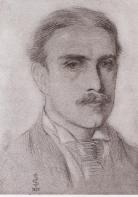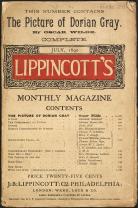Walter Pater and Oscar Wilde
Created by Bridget Kingston on Tue, 04/27/2021 - 19:45
This timeline gives basic context for Wilde's professional and personal relationship with Walter Pater.
Timeline
Chronological table
| Date | Event | Created by | Associated Places | |
|---|---|---|---|---|
| 1877 |
Oscar Wilde meets Walter PaterOscar Wilde was in his senior year at Magdalen College, Oxford when he first corresponded with essayist and critic, Walter Pater (1839-1894). Wilde, aware of Pater's great influence, sent him a copy of his first published article as a means to introduce himself. In his introduction, Wilde also expressed his admiration for The Renaissance. Pater had received harsh criticism for this collection of essays, mainly for his concise yet controversial Conclusion to The Renaissance. In his Conclusion, Pater implores readers to seek out and find those experiences which move them, claiming “To maintain this ecstasy is success in life.” These views challenged the typical Victorian mindset of reserved formality and repressed pleasure. Upon receiving such flattery, he invited Wilde to meet once he returned to Oxford. They met often for walks and tea, and continued in a similar fashion after Wilde left Oxford. They never were close friends, and it was generally known that each criticized the other behind closed doors. It has been noted in Wilde's biography that "Pater disliked Wilde personally while admiring his cleverness," and that Wilde held the opinion that "Dear Pater was always frightened of my propaganda" (81). https://victorianweb.org/authors/pater/hext2.html Ellmann, Richard. Oscar Wilde. London: Penguin, 1987 https://studio.covecollective.org/anthologies/columbia-college-chicago-o... https://wiki.uiowa.edu/display/vicwik/Walter+Pater%27s+The+Renaissance |
Bridget Kingston | ||
| 1887 |
Wilde Reviews Pater's "Imaginary Portraits"Wilde began to adopt more of Pater's aesthetic views in his own writing towards the late 1880's, with a few key differences. Pater's thoughts on aesthetics are transformed with wit in the preface to Dorian Gray: "It is the spectator, and not life, that art really mirrors" (3). Pater's ruminations on art and its subject can be seen as an influence, only Wilde presents this dense notion through witty and succinct prose.
At this same time, Wilde wrote highly complimentary reviews of Pater's newly published works, including "Imaginary Portraits" (1887) and "Appreciations With An Essay on Style" (1889). In his review entitled "Mr. Pater's Imaginary Portraits," Wilde concludes that "On the whole, then, this is a singularly attractive book. Mr. Pater is an intellectual impressionist." Pater incorporates the use of many forms, including scholarly essay, brief life, short story, allegory, lyrical ekphrasis, historical vignette, myth, and diary, to create imaginative written pictures, solidifying a relationship between life and art. "Each portrait typically focuses on an individual who is deeply solitary, an enigma to the world around him, yet inhabits a historical moment in which his peculiar desires become harbingers of epochal cultural transition." Three years later, Wilde would publish The Picture of Dorian Gray in Lippincott's Magazine, which echoes greatly the idea of a portrait solidifying the relationship between life and art.
https://victorianweb.org/authors/wilde/essays/5.html https://victorianweb.org/authors/pater/hext2.html http://www.gutenberg.org/files/4038/4038-h/4038-h.htm http://www.gutenberg.org/files/4037/4037-h/4037-h.htm Wilde, Oscar, and Joseph Bristow. “The Picture of Dorian Gray.” The Picture of Dorian Gray, Oxford University Press, 2006, p. 3. |
Bridget Kingston | ||
| 1891 |
Pater Reviews "The Picture of Dorian Gray"Pater's review of Dorian Gray ultimately distanced the two writers and altered their relationship forever, as they never met again after it was published. Pater was generous with his compliments, but they come off as largely dismissive. He argues that the "dainty Epicurean theory" adds to the "decorative colour of its central figure, like so many exotic flowers, like the charming scenery and the perpetual, epigrammatic, surprising, yet so natural, conversations, like an atmosphere all about it. All that pleasant accessory detail, taken straight from the culture, the intellectual and social interests, the conventionalities, of the moment, have, in fact, after all, the effect of the better sort of realism." This jab mocks Wilde's distate for realism, and drives home Pater's argument earlier in his review that Dorian Gray severely misses the mark at encompassing a true Epicurean spirit. The review concludes with Pater maintaining that "Mr. Wilde's work may fairly claim to go with that of Edgar Poe, and with some good French work of the same kind, done, probably, in more or less conscious imitation of it."
Pater's fear of moral reproach and Wilde's reveling in the media circus over his controversial ideas proved to be the biggest difference between the two, and is likely to be behind Pater's disapproval of Wilde. He was well aware of Wilde's homosexual encounters in his private life, especially after Wilde introduced him to Alfred Douglas in 1890. The infamous controversy surrounding The Picture of Dorian Gray was perhaps one step too far for Pater, only made all the more distressing by the memory of his painful experience over The Renaissance. https://studio.covecollective.org/anthologies/columbia-college-chicago-o... |
Bridget Kingston |



